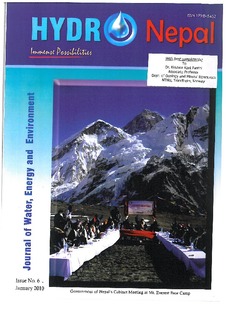| dc.contributor.author | Panthi, Krishna Kanta | |
| dc.contributor.author | Shrestha, Kiran Kumar | |
| dc.date.accessioned | 2017-10-03T12:30:49Z | |
| dc.date.available | 2017-10-03T12:30:49Z | |
| dc.date.created | 2010-10-25T14:16:44Z | |
| dc.date.issued | 2010 | |
| dc.identifier.citation | Hydro Nepal: Journal of Water, Energy and Environment. 2010, (6), 18-26. | nb_NO |
| dc.identifier.issn | 1998-5452 | |
| dc.identifier.uri | http://hdl.handle.net/11250/2458091 | |
| dc.description.abstract | The history of hydropower development in the Himalaya indicates that many tunnels have suffered from cost overruns and delays. These issues are directly dependent on the quality of rock mass and the permanent rock support applied in underground excavation. Right judgment and proper evaluation of the self supporting capability of the rock mass and the use of optimum rock support systems help considerably in reducing construction cost and delays. This paper examines such issues as geological conditions in the Himalayas and varying approaches and costs in tunnel construction. An assessment is made regarding the exclusion of permanent concrete lining in the headrace tunnel of the 72MW Middle Marsyangdi Hydro Project in Nepal. The project has 5.2 km fully concrete lined headrace tunnel that passes through fair to poor rock mass. The evaluation is based on the use of actually recorded rock mass quality of the headrace tunnel during construction and rock support principle used at the comparable Khimti Hydro Project headrace tunnel. The evaluation includes calculation of equivalent tunnel section for similar headloss, stability analysis, assessment of possible water leakage, and required injection grouting measures. We conclude that the headrace tunnel without permanent concrete lining was possible and would have been equally stable, at considerable financial savings. | nb_NO |
| dc.language.iso | eng | nb_NO |
| dc.publisher | Nepal Journals OnLine | nb_NO |
| dc.title | The use of Self Supporting Capacity of Rock Mass for Sustainable Hydropower: An Analysis of the Middle Marsyangdi Headrace Tunnel, Nepal | nb_NO |
| dc.type | Journal article | nb_NO |
| dc.type | Peer reviewed | nb_NO |
| dc.description.version | publishedVersion | nb_NO |
| dc.source.pagenumber | 18-26 | nb_NO |
| dc.source.journal | Hydro Nepal: Journal of Water, Energy and Environment | nb_NO |
| dc.source.issue | 6 | nb_NO |
| dc.identifier.doi | 10.3126/hn.v6i0.4188 | |
| dc.identifier.cristin | 349687 | |
| dc.description.localcode | Copyright (c) 2010 Hydro Nepal: Journal of Water, Energy and Environment | nb_NO |
| cristin.unitcode | 194,64,10,0 | |
| cristin.unitname | Institutt for geologi og bergteknikk | |
| cristin.ispublished | true | |
| cristin.fulltext | original | |
| cristin.qualitycode | 1 | |
